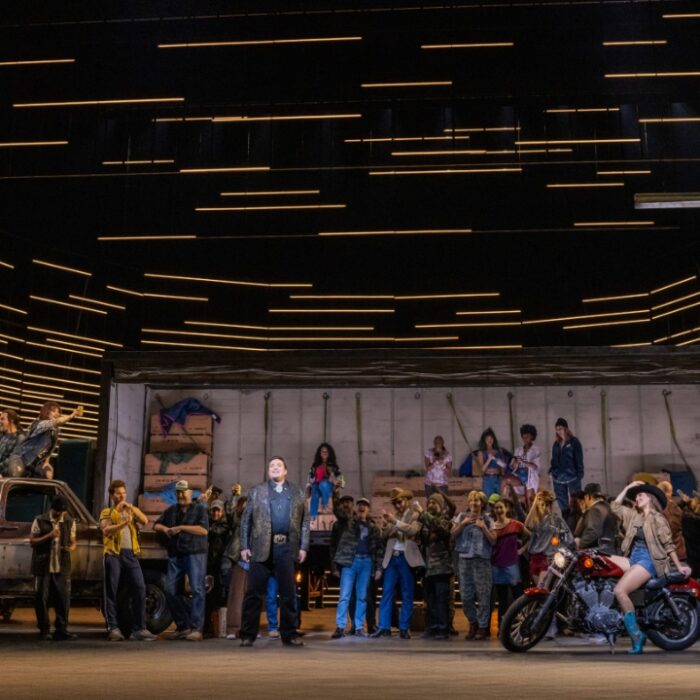
Berlin Philharmonic 2025 Review: Das Lied von der Erde
By Lois Silverstein
Mahler creates worlds. Each brings a musical feast. “Das Lied von der Erde” (The Song of the Earth), performed at the Berlin Philharmonic under Finnish conductor Sakari Oramo brought us another one. The “superstitious” Mahler did not want to label this work the Ninth, since both Beethoven and Schubert died after writing theirs, so he called it a symphony for two voices. The soloists for this performance were tenor Benjamin Bruns and Hungarian mezzo soprano Dorottya Láng. Mahler’s richly composed works were performed with an exceptional palette in multiple variations by Oramo. He conducted the opening selection, “Adagio” from the Tenth Symphony and “Das Lied von der Erde,” in total command, allowing plenty of room for each cluster of orchestral sound to reach its full range of expression.
The “Adagio,” which the Philharmonic is to perform under Kirill Petrenko on May 14, was about 20 minutes long. It is rich with variations and dissonant sounds, providing apt contrast to “Das Lied von der Erde.” There was some suggestion of the pentatonic sound that would follow, and the haunting melody, hiding and re-emerging, brought continuing surprise. Was this the downbeat of the ways Mahler would continue to compose had he lived? The composers who “completed” the Tenth Symphony affirmed this; he, as several of his fellow composers at the time, was exploring atonality in new and individual ways. Exotic tones and allusions were used through his unique instrumentation similar to Strauss, especially “Salome,” appearing in 1911, and also moments previewing Bruckner’s vastness, foreshadow the musical landscape beginning to unfold around him. “Adagio” was a good choice to precede “Das Lied von die Erde.”
“The Song of the Earth” followed the Intermission. The cycle “tells a story” about the quest for life’s meaning in six independent songs, derived originally from Chinese lyric poetry but later written in a German translation by Hans Bethge, “Die Chinesische Flöte,” derived from another German translation by Hans Heilmann, who derived it from a French translation of Marquis d’Hervey de Saint-Denys and Judith Gautier. Each of the poems or songs takes a particular facet of the exploration and gives it an original treatment. Each is sung by one singer in alternation.
In this production the performers sang it as Mahler composed it, for tenor and alto, although it has been sung by two male singers (tenor and baritone) and also by one singer doing both roles (tenor with piano), as well as one with the whole orchestra. The choice is not only technical, however. Here we have a human in dialogue with himself and also with the world and the universe at large. Mahler composed the work to show how the voices engage with one another when trying to reconcile himself to live life and leave it. The work deepens as one becomes more aware of the dual layers.
The opening song, “Das Trinklied vom Jammer der Erde,” is difficult and challenging. The tenor establishes the tension Mahler sets up throughout. How does one reconcile life with death, especially when one concedes that death is the end of everything? Tenor Benjamin Bruns tackled this with all he could muster. Bruns threw down the gauntlet in “Leben ist dunkel, ist der Tot” (Life is Dark, as is Death). The line follows each of the three stanzas of the song and accrues intensity as it does. This requires a tremendous effort at the outset. In addition to singing it over a full orchestra, Bruns poured himself into it. Notes and words disappeared into the well of the orchestra, although as Leonard Bernstein once said, no one really worries about understanding any of either there – a violent and proud disdain of sound and meaning without necessary understanding we are assaulted with as the statement of what we’re up against. Mahler seemed determined to make his point; Bruns strained, it seemed, although we could say he was wrestling with the essence of the message rather than Mahler. It was not clear. The song dramatized just how monumentally hard it is to live in a world replete with desire for pleasure and meaning, and with our own attempts to wrest these out of it, and come up, over and over again, empty. Bruns transmitted this almost uncomfortably. His whole body was thrown into the effort. The sound that emerged seemed both strained in its brashness and sometimes there was a big loss of notes.
Dorottya Láng followed with the second song, “Der Einsame im Herbst” (The Lonely One in Autumn). This was a sharp contrast and another side of the story. Further, it was another aspect of Mahler’s philosophical quest in the whole work. In this he introduced Eastern perspectives on mortality and a view of nature that might endure in a different way than what he and the west wrestle with. Láng introduced Autumn, the fall of the year, the earth beginning to decline, leaves falling and dying, light dimming, light dying, the declining earth in fall and the singer all alone – solitary in its midst. Láng sang with elegant thoughtfulness, keeping us conscious of the tone and timbre through the changes occurring all around us. Following the brutality of the previous song, here we have a calmer tone but Láng dramatized the lines perhaps too much. Her facial expressions and moderate gestures emphasized the shift with more attention than it needed. Lieder needs less drama than opera, or at least a different style. Its drama requires feeling less personal the way sculpture does when compared to painting. Mahler seemed to aim at marble rather than color even though Láng’s lively interpretation certainly brought the necessary contrast to what preceded it.
Bruns followed with the third song, “Von der Jugend” (From the Youth). This was short, witty, playful, singing with tenderness and lightness, particularly in the upper register. Some of his lower register, however, felt dull and without resonance, closer to speech.
Láng’s performance of song number four, “Von der Schönheit” (Of the Beauty), continued to emphasize the emotional scope, rendering her lines with interactive emotion. Her voice bridged the worlds of the impersonal with the here and now. Brun’s song number five, “Der Trunkene in Frühling” (The Drunken Man in Spring) brought more weight without strain and with a comfortable strength as well as bounty.
Everything led up to song number six, the great “Der Abschied” (Farewell), which Lang executed with appropriate gravitas and weight. The song is twice as long as any of the others and is the whole story of the cycle – farewell to the world, and to the earth. It was in no way ponderous, but rather thoughtful and touching. It was as if all were waiting for this moment – the attempt at uniting the splintered
All throughout the striking notes and messages of the individual songs, the orchestra carried the weight of the whole. The variety of instrumentation, the finesse of Oramo curating the powerful brass and winds, the clusters of instruments one after the other articulated emotional depth. Segment by segment, each orchestral section brought its own articulation of tension and contrast. Pentatonic scales rose and/or leaned into the traditional European modalities, keeping the work open to ways we might pull both Eastern and Western wisdom toward rather than away from each other. Horns blared out of strings with full energy; celesta diluted their abundant resonance, but without dissolving any of it. It was as if we were, moment by moment, compelled to cull from each what we could absorb and match it with its opposite. Or the two harps and the timpani? Could we use the wisdom of East and West as we make our journey toward some kind of understanding of our place in this world, in this life?
The Berlin Philharmonic is not reputed to be the best orchestra in the world for nothing. Omaro gave us plenty of time to rest within each segment, finessing the sounds with deliberation and care. At no point was any part of the orchestra alone for very long, however. Sequences of sound created a segue of intimacies which added up into a larger whole. A significant result of this was that each orchestral voice lived on its own while the quest for unity clearly was going on. It just wasn’t going to happen right away. We had a sense of the whole or any union being held off. Were we going to get that finally? Were we going to rise beyond individual and a sometimes isolating solitary experience, especially when so intense and private into any kind of union that might sustain us as individual ecstasy cannot?
The two soloists and the orchestra together throughout offered us new opportunities to listen and explore possibilities. Each singer pressed his and her individual range to integrate their part with what the whole aimed for. The tapestry was only complete, if that were possible at the end, but, all the way through, each section, no matter how small, contributed to creating it. Much like a cathedral, every gargoyle played its part. Each curlicue or flying angel, however singular, winds up no longer isolated, but contributing to the whole. Láng performance of “Abschied” gathered her forces to emphasize that result. The length of the piece and the way she slipped her voice into the whole landscape, allowed us to be absorbed into that quest. As Mahler once said to Bruno Walter, he hoped the audience would not go home and shoot themselves. Would they perhaps find a way to live in the world, and in nature with peace? And we, forty miles from the concert hall, in Sachsenhausen concentration camp, could we remember such sorrow and still keep the earth alive and renewed as this music does, in its beauty, in its bounty and rejoice, even if it is, as for Mahler, for too short a time? “We cannot live even a 100 years,” as one of the poems says, “but the earth may,” the earth, the earth, “ewig, ewig,” forever, always.


